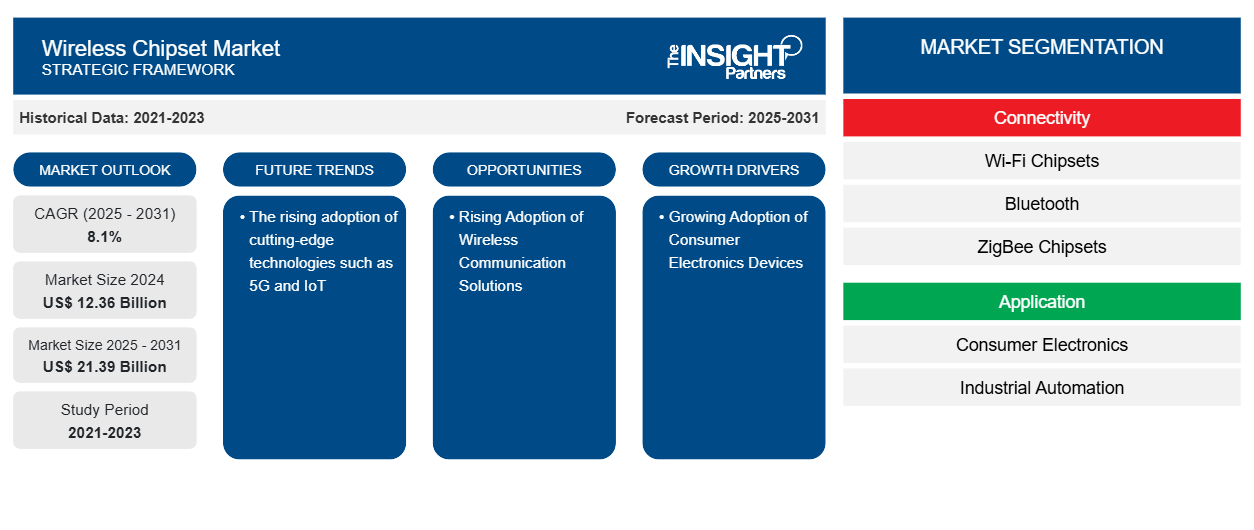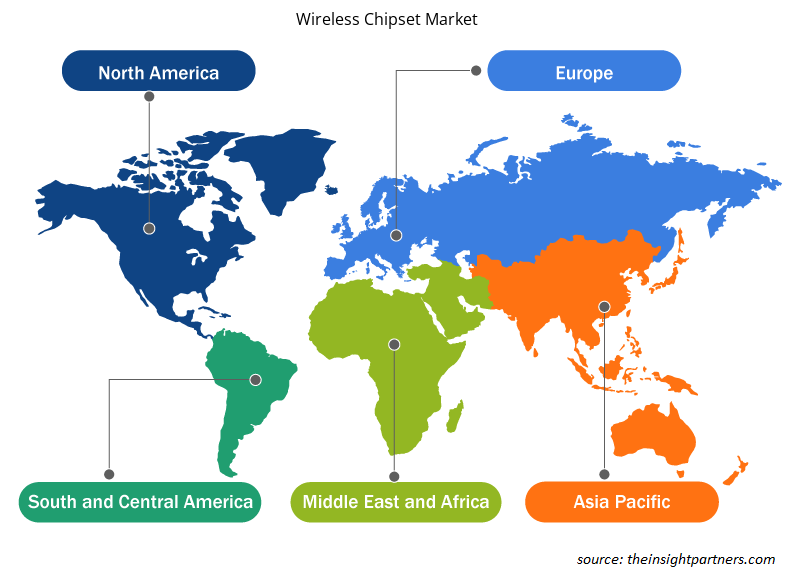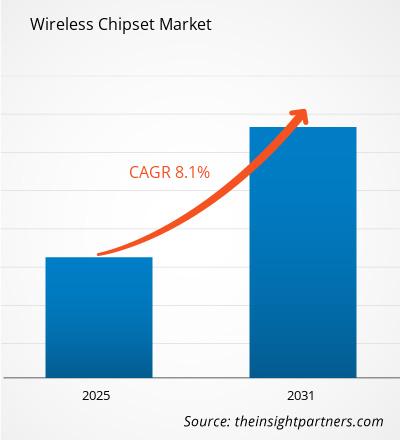The wireless chipset market size is projected to reach US$ 21.39 billion by 2031 from US$ 11.43 billion in 2023. The market is expected to register a CAGR of 8.1% during 2023–2031. The rising adoption of cutting-edge technologies such as 5G and IoT are likely to remain key trends in the market.
Wireless Chipset Market Analysis
The wireless chipset market is growing at a rapid pace due to the growing adoption of consumer electronics devices and the rising need for faster data transfer. The market is expanding steadily, driven by the increasing demand for Internet of Things (IoT) devices. Moreover, the rising adoption of wireless communication solutions and the evolution of augmented reality (AR) and virtual reality (VR) are providing lucrative opportunities for market growth.
Wireless Chipset Market Overview
A wireless chipset is a part of internal hardware that allows a device to connect to a wireless network. It is a set of hardware and software components that allow wireless communication between devices. A wireless chipset consists of three primary components: the radio, the baseband processor, and the firmware. The radio transmits and receives radio waves that transport data between devices. The baseband processor processes the signals broadcast and received by the radio, while the firmware manages the chipset's functionality. This chip is used in PCs and other wireless devices, typically in a laptop or wireless network card. Similarly, wireless routers and external WLAN adapters also have one chip, and they are frequently integrated into the computer itself.
Customize This Report To Suit Your Requirement
You will get customization on any report - free of charge - including parts of this report, or country-level analysis, Excel Data pack, as well as avail great offers and discounts for start-ups & universities
Wireless Chipset Market: Strategic Insights

- Get Top Key Market Trends of this report.This FREE sample will include data analysis, ranging from market trends to estimates and forecasts.
You will get customization on any report - free of charge - including parts of this report, or country-level analysis, Excel Data pack, as well as avail great offers and discounts for start-ups & universities
Wireless Chipset Market: Strategic Insights

- Get Top Key Market Trends of this report.This FREE sample will include data analysis, ranging from market trends to estimates and forecasts.
Wireless Chipset Market Drivers and Opportunities
Growing Adoption of Consumer Electronics Devices to Favor Market
Wireless chipsets are essential components of smartphones and tablets, allowing them to connect to Wi-Fi, cellular networks, and Bluetooth devices. They enable users to utilize the internet, make phone conversations, send text messages, and transfer data wirelessly, making them extremely versatile and convenient. Similarly, wireless chipsets are also used in laptop and desktop computers to provide Wi-Fi and Bluetooth connectivity. They enable users to connect to wireless networks and peripherals such as wireless keyboards, mouse, and headphones, improving computing comfort and convenience. The advantages of wireless chipsets in these devices are increasing their adoption among consumer electronics manufacturers. They enable faster and more reliable data transfer, eliminate the need for physical connections, and offer increased convenience and flexibility.
Rising Adoption of Wireless Communication Solutions
The rising adoption of wireless communication solutions among industries is creating opportunities in the market. In the rapidly changing world of wireless communication, market players are encouraged to develop new innovative products or upgrade their existing portfolio to fulfill dynamic customers' needs. For instance, in August 2023, Lumenci developed a Wi-Fi 6E chipset that provides seamless connectivity with improved network efficiency to users working in highly dense environments. It is the most recent improvement in wireless technology, specifically an expansion of the Wi-Fi 6 (802.11ax) standard. Wi-Fi 6E chipset primarily operates in the 6 GHz frequency band, providing a larger spectrum with considerable performance gains over earlier Wi-Fi generations. Wi-Fi 6E chipset provides significant benefits to users, including faster speeds, more capacity, lower latency, and less interference, making it ideal for high-bandwidth applications across multiple connected devices.
Wireless Chipset Market Report Segmentation Analysis
Key segments that contributed to the derivation of the wireless chipset market analysis are connectivity and application.
- Based on connectivity, the wireless chipset market is divided into Wi-Fi chipsets, Bluetooth, ZigBee chipsets, Z-wave chipsets, and others. The Wi-Fi chipsets segment held a larger market share in 2023.
- In terms of application, the market is segmented into consumer electronics, industrial automation, and others. The consumer electronics segment is anticipated to expand during the forecast period.
Wireless Chipset Market Share Analysis by Geography
The geographic scope of the wireless chipset market report is mainly divided into five regions: North America, Asia Pacific, Europe, Middle East & Africa, and South & Central America.
Asia Pacific region plays a substantial role in the wireless chipset market. Factors such as the expanding demand for high-speed internet access, the deployment of 5G networks, and the increasing adoption of lot technology contribute to the region's growth and present numerous opportunities in the wireless chipset market. The Asia Pacific region is home to many internet users, with China being a significant contributor. In 2021, the area witnessed the highest number of internet users globally, indicating a strong demand for high-speed internet access. This demand fuels the need for advanced wireless chipsets to deliver faster data transfer rates and improved network performance. The country's extensive use of wireless technologies, particularly in the banking industry, has expanded the wireless chipset market. The growing dominance of smart devices and the growing demand for wireless connectivity across industries further drive the growth of the wireless chipset market.
Wireless Chipset Market Regional Insights
The regional trends and factors influencing the Wireless Chipset Market throughout the forecast period have been thoroughly explained by the analysts at The Insight Partners. This section also discusses Wireless Chipset Market segments and geography across North America, Europe, Asia Pacific, Middle East and Africa, and South and Central America.

- Get the Regional Specific Data for Wireless Chipset Market
Wireless Chipset Market Report Scope
| Report Attribute | Details |
|---|---|
| Market size in 2024 | US$ 12.36 Billion |
| Market Size by 2031 | US$ 21.39 Billion |
| Global CAGR (2025 - 2031) | 8.1% |
| Historical Data | 2021-2023 |
| Forecast period | 2025-2031 |
| Segments Covered |
By Connectivity
|
| Regions and Countries Covered | North America
|
| Market leaders and key company profiles |
Wireless Chipset Market Players Density: Understanding Its Impact on Business Dynamics
The Wireless Chipset Market is growing rapidly, driven by increasing end-user demand due to factors such as evolving consumer preferences, technological advancements, and greater awareness of the product's benefits. As demand rises, businesses are expanding their offerings, innovating to meet consumer needs, and capitalizing on emerging trends, which further fuels market growth.
Market players density refers to the distribution of firms or companies operating within a particular market or industry. It indicates how many competitors (market players) are present in a given market space relative to its size or total market value.
Major Companies operating in the Wireless Chipset Market are:
- Atmel Corporation
- Broadcom Inc.
- Intel Corporation
- MediaTek Inc.
- NXP Semiconductors N.V.
- Qorvo, Inc.
Disclaimer: The companies listed above are not ranked in any particular order.

- Get the Wireless Chipset Market top key players overview
Wireless Chipset Market News and Recent Developments
The wireless chipset market is evaluated by gathering qualitative and quantitative data post primary and secondary research, which includes important corporate publications, association data, and databases. A few of the developments in the wireless chipset market are listed below:
- In November 2023, MediaTek, a pioneer in adopting Wi-Fi 7 technology, further solidified its position as a leader in the industry by introducing its latest offerings, the Filogic 860 and Filogic 360 solutions. These second-generation additions enhance Media Tek's already extensive portfolio of Wi-Fi 7 solutions, making it the most comprehensive in the industry. With these new solutions, MediaTek aims to expand its platform of state-of-the-art products that leverage the latest advancements in connectivity technology. (Source: MediaTek, Company Website, November 2023)
- In September 2023, Intel Corporation and Broadcom Inc. recently collaborated to present an unprecedented demonstration of cross-vendor compatibility in the Wi-Fi 7 domain. The showcase featured an Intel CoreTM processor-based laptop equipped with a cutting-edge Wi-Fi 7 solution seamlessly connected to a Broadcom Wi-Fi 7 access point. This groundbreaking trial achieved over-the-air speeds exceeding 5 gigabits per second, surpassing previous industry benchmarks. The successful collaboration between these two industry leaders highlights their commitment to advancing wireless technology and demonstrates the potential for future Wi-Fi 7 implementations across various devices and networks. (Source: Intel Corporation, Company Website, September 2023)
- In June 2023, Broadcom Inc. has recently announced the availability of sample products from its second generation of wireless connectivity chipset solutions designed for the Wi-Fi 7 ecosystem. These solutions cater to various applications, including Wi-Fi routers, residential gateways, enterprise access points, and client devices. Introducing these new chips further enhances Broadcom's existing product ecosystem, including their first-generation Wi-Fi 7 chips. The second-generation chips not only provide additional functionality but also expand the market reach of Broadcom's offerings. This announcement signifies Broadcom's commitment to advancing wireless connectivity technologies and meeting the evolving needs of various industries and consumers. (Source: Broadcom Inc, Company Website, June 2023)
Wireless Chipset Market Report Coverage and Deliverables
The “Wireless Chipset Market Size and Forecast (2021–2031)” report provides a detailed analysis of the market covering below areas:
- Wireless chipset market size and forecast at global, regional, and country levels for all the key market segments covered under the scope
- Wireless chipset market trends as well as market dynamics such as drivers, restraints, and key opportunities
- Detailed PEST/Porter’s Five Forces and SWOT analysis
- Wireless chipset market analysis covering key market trends, global and regional framework, major players, regulations, and recent market developments
- Industry landscape and competition analysis covering market concentration, heat map analysis, prominent players, and recent developments for the wireless chipset market
- Detailed company profiles
Frequently Asked Questions
What are the driving factors impacting the wireless chipset market?
The growing demand for Wi-Fi among SMEs and the rising demand for high-speed internet access and 5G networks are the major factors that propel the global wireless chipset market.
What is the expected CAGR of the wireless chipset market?
The global wireless chipset market is estimated to register a CAGR of 8.1% during the forecast period 2023–2031.
What are the future trends of the wireless chipset market?
The rising adoption of cutting-edge technologies such as 5G and IoT to play a significant role in the global wireless chipset market in the coming years.
What are the options available for the customization of this report?
Some of the customization options available based on the request are additional 3–5 company profiles and country-specific analysis of 3–5 countries of your choice. Customizations are to be requested/discussed before making final order confirmation, as our team would review the same and check the feasibility.
Which are the leading players operating in the wireless chipset market?
The key players holding majority shares in the global wireless chipset market are Atmel Corporation, Broadcom Inc., Intel Corporation, MediaTek Inc., NXP Semiconductors N.V., Qorvo, Inc., Qualcomm Technologies Inc., Silicon Laboratories, Inc., Sony Corporation, and Texas Instruments Inc.
What are the deliverable formats of the wireless chipset market report?
The report can be delivered in PDF/PPT format; we can also share excel dataset based on the request.
- Historical Analysis (2 Years), Base Year, Forecast (7 Years) with CAGR
- PEST and SWOT Analysis
- Market Size Value / Volume - Global, Regional, Country
- Industry and Competitive Landscape
- Excel Dataset
Testimonials
Reason to Buy
- Informed Decision-Making
- Understanding Market Dynamics
- Competitive Analysis
- Identifying Emerging Markets
- Customer Insights
- Market Forecasts
- Risk Mitigation
- Boosting Operational Efficiency
- Strategic Planning
- Investment Justification
- Tracking Industry Innovations
- Aligning with Regulatory Trends
Yes! We provide a free sample of the report, which includes Report Scope (Table of Contents), report structure, and selected insights to help you assess the value of the full report. Please click on the "Download Sample" button or contact us to receive your copy.
Absolutely — analyst assistance is part of the package. You can connect with our analyst post-purchase to clarify report insights, methodology or discuss how the findings apply to your business needs.
Once your order is successfully placed, you will receive a confirmation email along with your invoice.
• For published reports: You’ll receive access to the report within 4–6 working hours via a secured email sent to your email.
• For upcoming reports: Your order will be recorded as a pre-booking. Our team will share the estimated release date and keep you informed of any updates. As soon as the report is published, it will be delivered to your registered email.
We offer customization options to align the report with your specific objectives. Whether you need deeper insights into a particular region, industry segment, competitor analysis, or data cut, our research team can tailor the report accordingly. Please share your requirements with us, and we’ll be happy to provide a customized proposal or scope.
The report is available in either PDF format or as an Excel dataset, depending on the license you choose.
The PDF version provides the full analysis and visuals in a ready-to-read format. The Excel dataset includes all underlying data tables for easy manipulation and further analysis.
Please review the license options at checkout or contact us to confirm which formats are included with your purchase.
Our payment process is fully secure and PCI-DSS compliant.
We use trusted and encrypted payment gateways to ensure that all transactions are protected with industry-standard SSL encryption. Your payment details are never stored on our servers and are handled securely by certified third-party processors.
You can make your purchase with confidence, knowing your personal and financial information is safe with us.
Yes, we do offer special pricing for bulk purchases.
If you're interested in purchasing multiple reports, we’re happy to provide a customized bundle offer or volume-based discount tailored to your needs. Please contact our sales team with the list of reports you’re considering, and we’ll share a personalized quote.
Yes, absolutely.
Our team is available to help you make an informed decision. Whether you have questions about the report’s scope, methodology, customization options, or which license suits you best, we’re here to assist. Please reach out to us at sales@theinsightpartners.com, and one of our representatives will get in touch promptly.
Yes, a billing invoice will be automatically generated and sent to your registered email upon successful completion of your purchase.
If you need the invoice in a specific format or require additional details (such as company name, GST, or VAT information), feel free to contact us, and we’ll be happy to assist.
Yes, certainly.
If you encounter any difficulties accessing or receiving your report, our support team is ready to assist you. Simply reach out to us via email or live chat with your order information, and we’ll ensure the issue is resolved quickly so you can access your report without interruption.















The List of Companies
1. Atmel Corporation
2. Broadcom Inc.
3. Intel Corporation
4. MediaTek Inc.
5. NXP Semiconductors N.V.
6. Qorvo, Inc.
7. Qualcomm Technologies Inc.
8. Silicon Laboratories, Inc.
9. Sony Corporation
10. Texas Instruments Inc.






 Get Free Sample For
Get Free Sample For